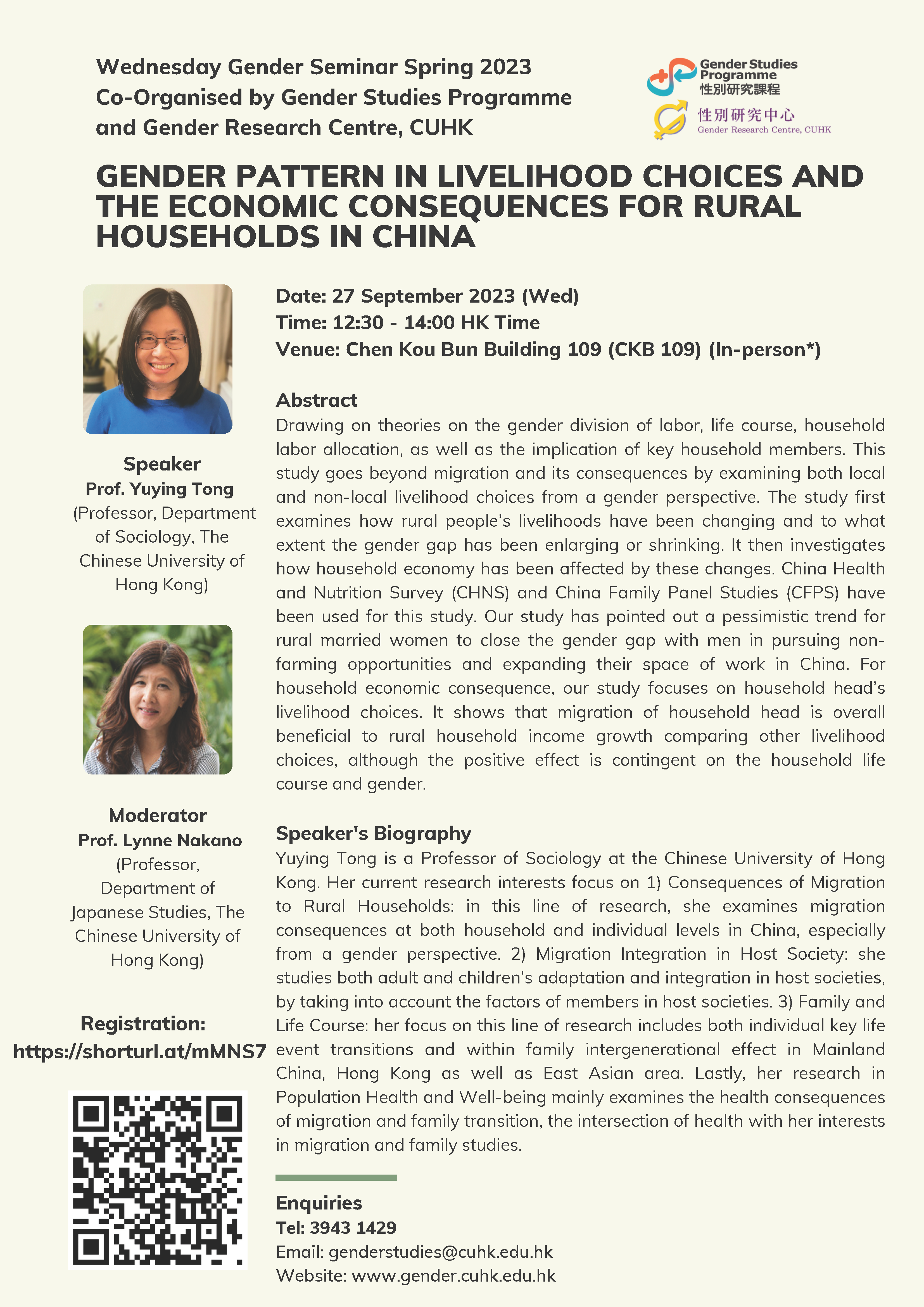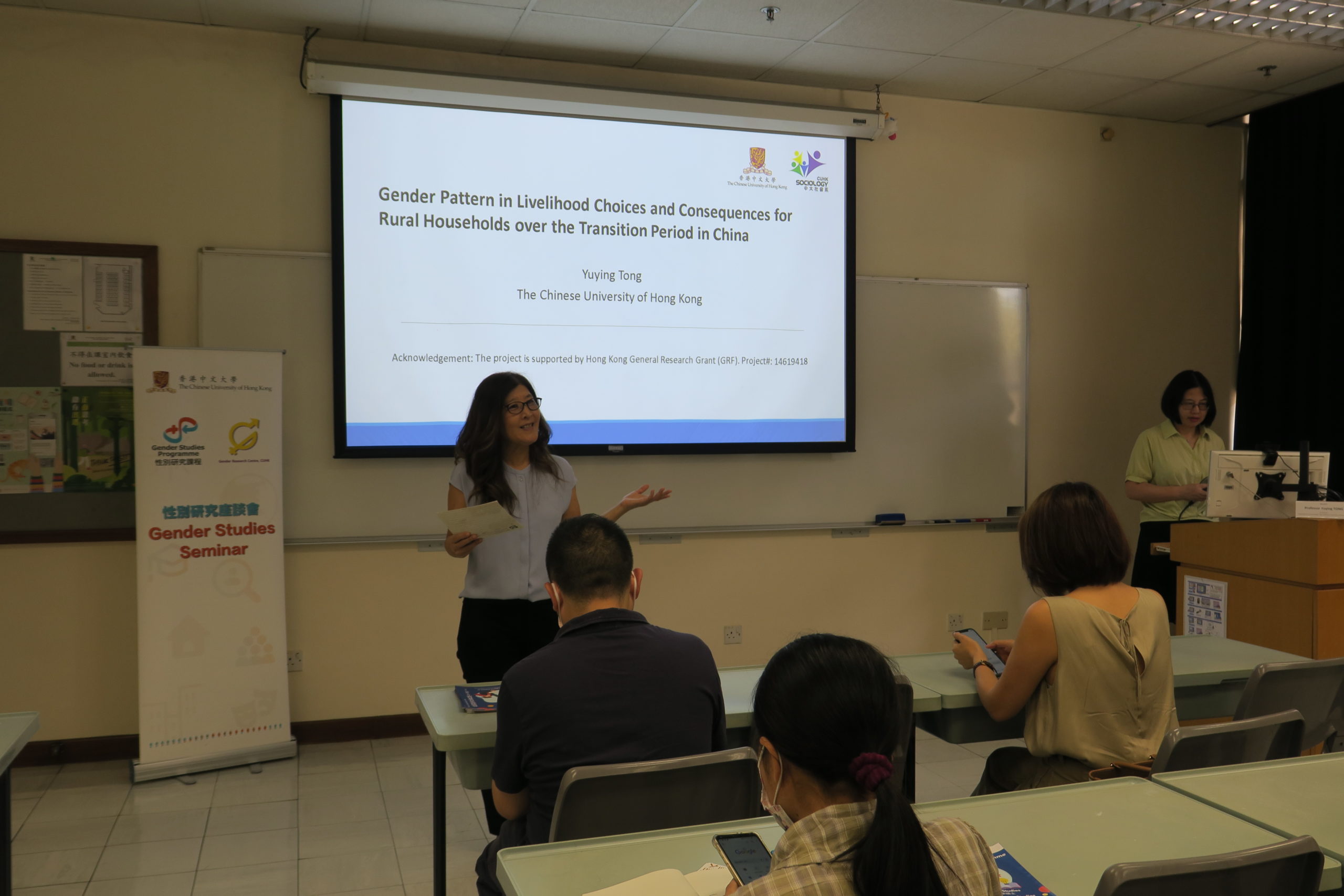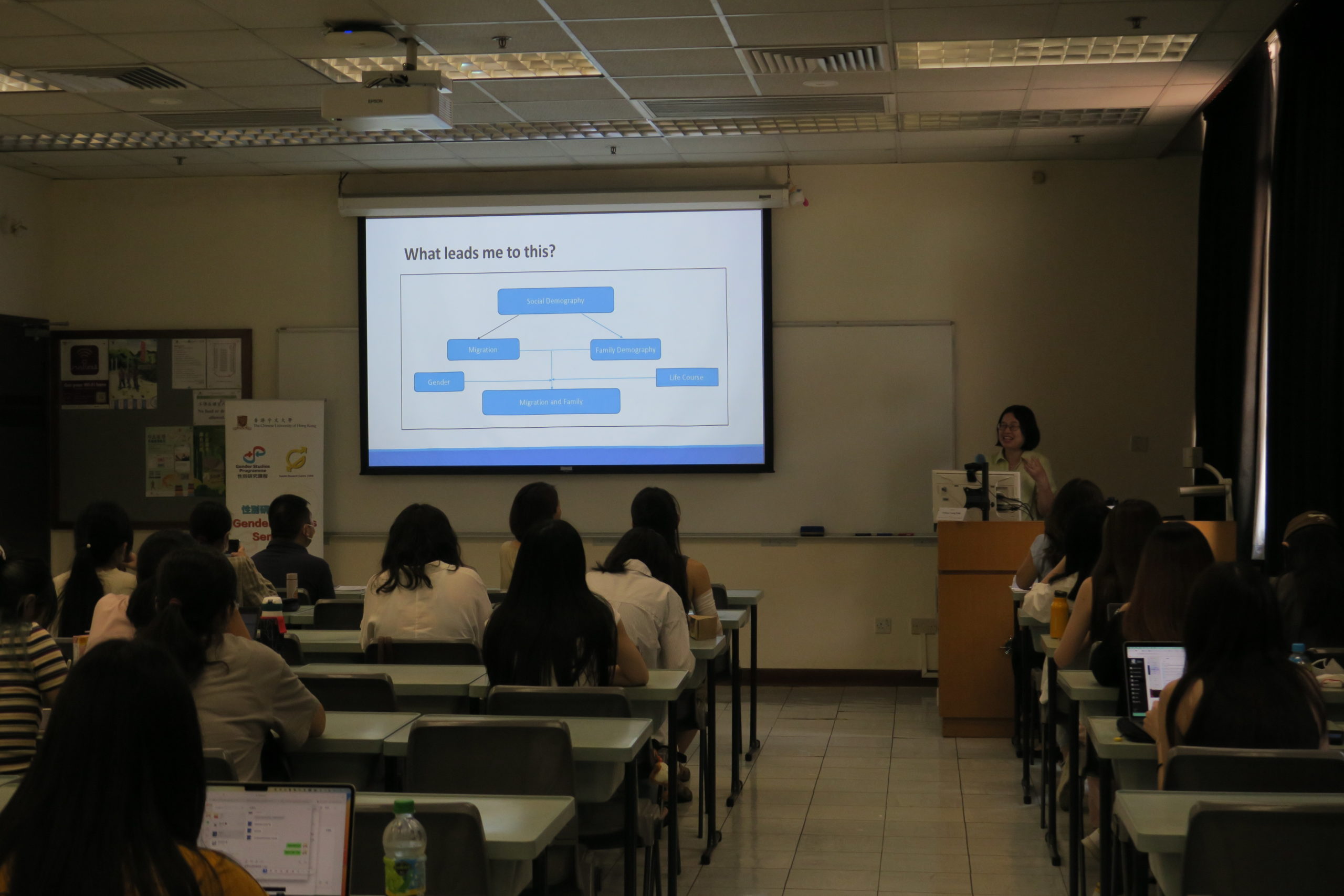Date: 27 Sep 2023 (Wed)
Under the liberation theory, women got out of house and work just like men and argued that “women substituted for men and freed men to undertake more new projects. Later, collectivization during the 1950s dismantled the house as a production unit but facilitated women’s participation in agricultural work. However, women still received lower work points although they did the same work as men. The economic reform launched in the late 1970s led to agricultural decollectivization and made the household once again the basic unit of production and in early reform era, the main strategy is to pursue local non-farm work for diversity such as township enterprises. So women take up more responsibilities in farming and also do some sideline work during off-farm seasons. After mid-1990s, migration to other places has become more dominant compared to local non-farm opportunities.
Under some theoretical background, we can hypothesize that:
- Compared to women, men are more likely to engage in non-farm work.
- By renegotiated gender role and with more opportunities, over time there will be a convergence of men and women in non-farm labor force participation.
- Marriage may set a constraint for rural woman and the extent of it has reduced over time.
- Women are more likely to pursue jobs in cities where there are more gender equal opportunities but the gap is reducing over the time.
The study find that although the gap between unmarried men and women has closed over time, there is no sign that the gap between married is closing. Women, in particular married women, are behind men in expanding both local and distant non-farm livelihood choices.
This reminds me of the topic of whether the active choice of a housewife is considered a woman’s freedom, which was much debated in mainland China before. I think we can discuss that being a housewife is a choice, but should not forget that society still doesn’t have a reasonably positive perception of the unpaid labor of housewives. We need to see the unresolved problems underneath this structural oppression and left behind by the patriarchal tradition. Women are facing many social problems.
撰文:GUO, Yijia
In the past few decades, with the rapid growth of rural areas and the increasing disassociation between livelihood and agriculture, rural people seemed to have more searches on their livelihood choices. During historical periods such as the “Great Leap Forward” and the Economic Reform periods, people began to focus on women’s agricultural work capability. Instead of aligning with the traditional communal gender role expectations, women were encouraged to leave their houses and work just like men. However, women were considered “substituting for men” or getting lower work points despite doing the same work as men.
Based on this background, the speaker introduced two studies to discuss the gender pattern in livelihood choices and consequences for rural households over the transition period in China. In the first study, researchers examined whether the gender gap and female disadvantages in livelihood choices have changed by analyzing data from the China Health Nutrition Survey. The sample were rural people aged between 18 to 54 years old. Results found that more rural people participated in non-farm work over time. Marital status constrained both men and women to take on non-farm jobs. Furthermore, though unmarried people did not show significant gender differences in their livelihood strategies, married women were less likely to choose non-farm jobs than married men, and this gap seemed not to be narrowed over time.
In the second study, researchers considered the key household members and compared female and male heads’ livelihood choices. They analyzed the data from The China Family Panel Studies and their sample was married rural people aged 20-65. According to their results, more people chose distant non-farm work over time. People were more likely to take on distant non-farm jobs when their household heads were young, especially when they were women. This livelihood choice from the household head was a strong predictor of household income growth. These results implicated that the livelihood choices of rural people are gendered and the family status may predict and affect rural people’s livelihood choices and consequences.
撰文: HE, Chuting
The theme of the second week’s seminar was “Gender pattern in livelihood choices and consequences for rural households over the transition period in China”, which was shared by Prof. Yuying Tong. She recounted two separate but connected studies under this project.
The first study focused on “the expanding search for work: gender gap in rural Chinese people’s livelihood changes from 1989 to 2015”. In the past few decades, rural areas around the world have experienced rapid growth in the diversification of rural household livelihood strategies. In China, the diversification process was accompanied by some important historical periods. Against this background, three research questions were posed to explore what are the gaps in livelihood choices between men and women. The hypotheses were analyzed by using data and samples from the China Health Nutrition Survey, identifying variables and incorporating APC models. Three conclusions were deduced as follows. First, men are more likely to work in non-farm positions and the gender gap shows little sign of convergence. Second, the gap between unmarried men and women is narrowing but for married women, the closing trend is somewhat handicapped. Third, women are behind men in expanding both local and distant non-farm livelihood choices.
The second study was a continuation of the first, which focused on key family members. The topic was “Female vs. men head’s livelihood choices and household income growth in rural China from 2010 to 2018″. The debate has been continuing for decades on whether migration as a livelihood choice is beneficial to rural household economic development. From the family life course perspective, the study used family as the unit of analysis and the household head’s age represented the household life course stage. The conclusions were drawn by utilizing data from the China Family Panel Studies (2010-2018) with Growth Curve models. The results showed that the livelihood choice of the household head is a strong indicator of household income growth in terms of both intercept and slope. At the same time, the migration of the household head generally favored the growth of rural household income.
撰文: HU, Bei
At the beginning, the author briefly introduced her social demography backgroud and the inflence of gendered life course, which finally led her to the subject of migration and family.
The first research is about the gender division of labor and industrial changes in rural areas of China. In the process of upgrading the industry, the separation of agricultural jobs and non-farm jobs, and the separation of places of residence and work are two major trends around the world. Gender role specialization and renegotiation have provided a theoretical basis for those phenomena. This study uses a sample of the labor force in rural areas in recent decades, using agricultural labor and non-agricultural labor as the benchmark, to examine women’s disadvantaged status in job opportunities, the convergence of the gender gap, and the impact of marital status on it. Empirical results show that men are indeed more likely to obtain non-agricultural job opportunities, and the gender gap never decreases. Additionally, marriage is proved to be an obstacle for women to purse their own career freely, which forms a stark contrast to male partners both in local and distance non-agricultural jobs. Trends for gender equality at work in rural areas remain bleak, in consequence of which private and public support should be provided to rural women, especially those who are married and have children.
The second research focus on the migration of rural household heads. Although the dual impact of migration on household economic status has often been discussed, local non-farm labor force is largely neglected, as well as their livelihood chioces and outcomes. This research concentrates on non-migrants and adopts a ‘house life course’ perspective, in order to study livelihood chioces and income growth trajectory. It turns out that the household heads’ livelihood chioces can strongly predict household income, and the migration of them is economically beneficial; However, such effect is contingent on their life course–it becomes very different between farming group and non-farming group, which means that we are supposed to separate these two groups when studying left-behind villagers.
撰文:JIANG, Yufei
The topic of the lecture on September 27th is Gender Pattern in Livelihood Choices and Consequences for Rural Households over the Transition Period in China.
Two separate but connected studies under this research project
Study A: The Expanding Search for Work: Gender Gap in Rural Chinese People’s Livelihood Changes from 1989 to 2015
Background:
Under the influence of China’s special historical moments such as the “Great Leap Forward” and economic reform,Livelihood has become disassociated with agriculture overtime and Increased labor mobility has separated the locations of work and home places for rural people.
3 conclusions emerged from the study A:
1. In terms of gender labor division, men are more likely to do non-farm work, and gender differences still exist.
2. Married women have greater barriers to work than married men.
3. The immigration gap between the two groups – married men and married women working locally as non-farm laborers – has been widening.
4. Rural women need family and institutional support to continue their non-agricultural work after marriage and childbirth.
Study B:Considering the Key Household Members: Female vs. Men Head’s Livelihood Choices and Household Income Growth in Rural China: 2010 to 2018
Background:
There has been a decades-long debate about whether migration as a livelihood option is beneficial to the economic development of rural families, with some arguing that it benefits the family and others arguing that it has a negative impact.
2 conclusions emerged from the study B:
1. When examining the left-behind villagers, it is necessary to choose to separate the two livelihoods.
2. The migration choice of household heads contributes to rural household income growth.
Through this class, I paid attention to the gender inequality in labor distribution in rural areas that I had never paid attention to before, and the fact that married men and women also face great differences in work after marriage. I will also have a deeper understanding of gender studies, in fact, not only limited to the broad level, in fact, those remote areas of gender issues are also worthy of attention
撰文:WANG, Ziqi





A
A
A
聯絡我們